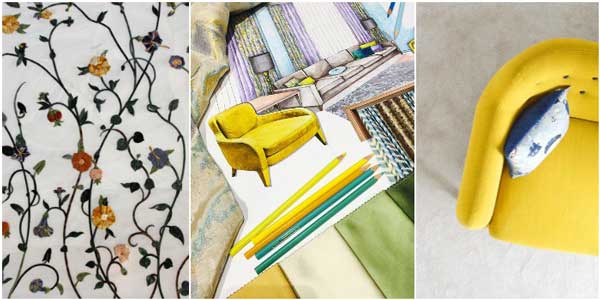Understanding Fabrics in Your Interior Decorating
Well-decorated homes have an aura of effortless beauty, achieved by a subtle use of décor elements, from colours and patterns, to lighting and fabrics. Those skilled in interior design know that what truly matters isn’t the size of a home, but their ability to emphasise its beauty by using the available resources, and, above all, using them effectively.
First things first
You need to know your home, its features and strengths, and then use different elements, such as fabrics, in a way that will accentuate those features. A monotone living space can easily gain charm by using fabrics and their decorative flair. However, before introducing layers of different fabrics to your home, you should consider several aspects that can influence your decorating choices. Everything from the colour scheme of a room, to the general mood and the types of fabric are factors that will affect your decision. The simplest way to decide on all of this is to imagine the room – visualisation is a springboard that will lead you to your perfect décor. Depending on your needs, you can even have fabrics created to meet your specific needs.
Introducing fabrics Once you’ve laid your eyes on all those beautiful fabrics, you’ll be tempted to just close them and choose randomly. Nonetheless, you need to resist the allure of their soft feel, intricate patterns and enticing colours, because each type of fabric is unique in its own way.
- As a natural fabric of undeniable elegance, silk has always been used to create a lush and sophisticated look in home décor. Despite its aesthetic appeal, this delicate fabric isn’t the best choice for upholstery, but rather for accent pillows or covers in less crowded areas, such as bedrooms.
- Rayon is a frequently used silk alternative also known as “art silk”. It has a shiny texture and better durability than silk, but it can easily wrinkle, so you should avoid using it for your sofa.
- Cotton is another natural fabric that enjoys great popularity due to its durability and comfort. Not only does it come in various weaves and weights, it can also work well with a variety of different styles. However, its main drawback is that it stains easily, so you should consider opting for a cotton blend instead of pure cotton.
- Their resistance to wrinkles, functionality and comfort make polyester fabrics a perfect choice for sitting areas. However, this synthetic fibre is more commonly used in a variety of blends with other fabrics, than in its pure form. For example, microfibre is a combination of polyester and nylon often used in home décor because of its durability, comfort and light weight.
- The softness and wool-like texture of acrylic fibre is what makes it a popular alternative to wool and cashmere. This type of fibre is also durable, resistant to wrinkles, stains and shrinkage, and holds colour well, which is why it’s often used in high-traffic areas.
The possibilities of fabrics
With a bit of creativity, your options of using different fabrics and bringing a sense of novelty to your home décor are almost endless. Fabrics are typically used for accent throw pillows that can easily transform a room by accentuating its subtle features, such as patterns or colour palettes. Since these are smaller elements, you can experiment with patterned fabrics in different colours that you wouldn’t normally use in your décor. Another stylish way to introduce intricately designed fabrics to your décor is accentuating with curtains.
However, when choosing fabrics for curtains, you should use a sample to see whether that type of fabric works well with the general style of the room, including the floors, walls, colour scheme, and furniture. Your furniture can be used as a canvas offering a variety of opportunities for décor experimentation. The upholstery fabric you choose can help you set the mood with its enticing design and captivating colours. Additionally, you should choose upholstery fabrics depending on a room’s purpose, for example, more durable ones should be used in the living room. The play of patterns
When combining patterned fabrics in your home décor, the general rule is to choose three different pattern designs that share at least one colour. Afterwards, you should decide which pattern is your primary one, and then distribute them by following the 60/30/10 rule. While the primary fabric will be used in 60% of the room, the secondary and tertiary will take up 30% and 10% respectively. This is a great way to create an interesting yet balanced look using differently patterned fabrics. If used effectively, fabrics can add depth and warmth to your home while simultaneously breaking the monotony. Don’t be afraid to experiment with different fabrics, but use them to give your décor character.
Author’s Bio: Lana Hawkins is an architecture student and the editor-in-chief on Smooth Decorator. She enjoys writing about interior decoration and landscaping. Lana is interested in sustainability and green building, and that’s where she gets most of her inspiration.
You might also like...
-
Crafting a Legacy: The Story of Saleh Abrahams and Constantia Fabrics

In a quiet corner of Cape Town, where creativity meets craftsmanship, Saleh Abrahams is weaving more than just fabric—he’s weaving a legacy. As the founder of Constantia ...
-
Woodheads : Bringing Your Designs to Life with Fabric and Leather Printing

Take your product to the next level in design and production with selected fabrics and fabric printing services from Woodheads. Print-Ready Fabric Print-ready fabric offers ...
-
Stuart Graham Textiles For Visually Stimulating Schemes

Infuse energy into your home with personality-filled palettes and bold fabrics. Creating spaces that bring joy starts and ends with your design choices. Use ...
-
Kehls

If you are wanting the look of leather, suede or hide but do not want the natural product, Kehls can offer you a variety of ...


























